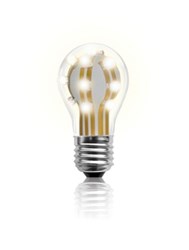MIDs With LPKF LDS PowderCoating

With two versions of an LDS-capable powder coating, three-dimensional metal parts can be turned into LED substrates. Both versions are now available.
Since the LPKF LDS PowderCoating was first announced in fall 2013, developers have expressed interest in using it in a multitude of applications. New product layout possibilities are opened up for producers of LED lights with the LDS powder coating, which enables any spatial arrangement of LEDs and offers good thermal properties.
In the laser direct structuring (LDS) process, a part is normally made from a plastic material containing an LDS additive. The laser prints the conductive trace structures on the surface. Initially copper and then nickel and gold layers are built up on these structures in a subsequent electroless metallization bath.
LPKF LDS PowderCoating
With the LPKF LDS PowderCoating, a metal base substrate, not an LDS plastic, is coated. Powder coating works well on metal surfaces such as steel or aluminum, but it also works on electrically conductive plastics. The powder is applied in an electrostatic process, which guarantees a homogeneous coating of precisely controllable thickness.
The metal substrates assume mechanical functions, aid in heat dissipation, and serve as contacts for the LEDs applied to them. The coated metal parts can be laser-structured and metallized in the same way that plastic parts are.
Two Versions
Two versions of LPFK LDS PowderCoating – “PES 200” and “PU 100” – are available. The satin PES surface has been optimized for high me-chanical stability, whereas the glossy PU 100 features more robust chemical and thermal properties. At minimum coating thicknesses of approx. 80 µm and 60 µm, the two powders offer good dielectric strengths when tested using AC voltages greater than 4 kV. For reasons of mechanical stability and adhesion, a minimum corner radius of 2 mm must be complied with when PU 100 is used. The adhesion strength of the elec-tronic components on the traces is 90–120 N, similar to the values found in FR4 and other conventional circuit boards.
PU 100 is approved for soldering for duration of five seconds at 270°C, whereas PES 200 is limited to 240°C for the same period. According to the results of preliminary tests, PU 100 is suitable for V-0 (UL-94) certification. Applications for certification have been submitted for both materials.
Both powder coatings are available in 2 kg (test sample) and 20 kg (series production) containers. LDS PowderCoating is neither a dangerous good nor a hazardous material and can be processed like a conventional powder coating product.
Source: LPKF
